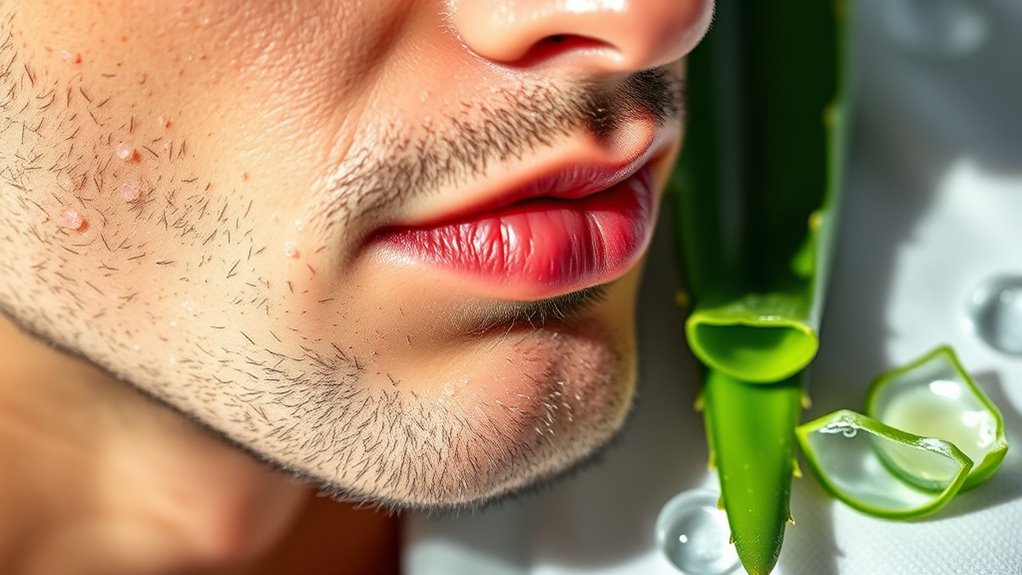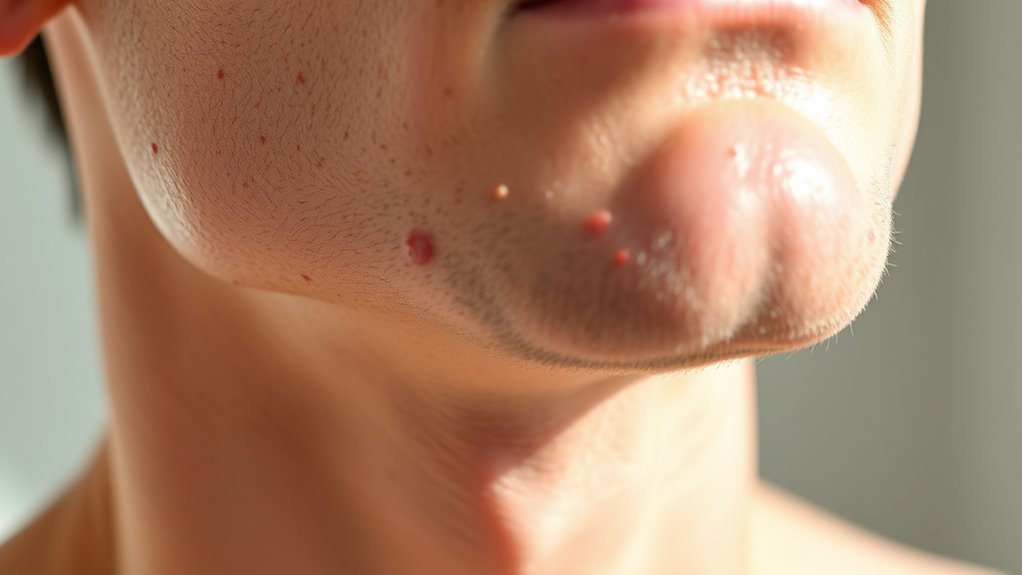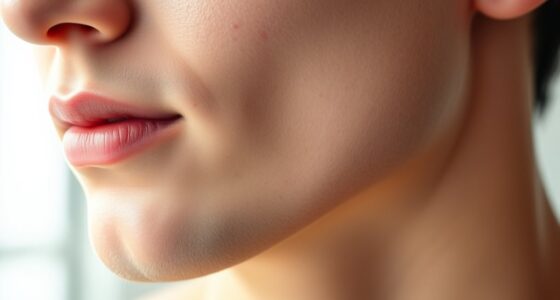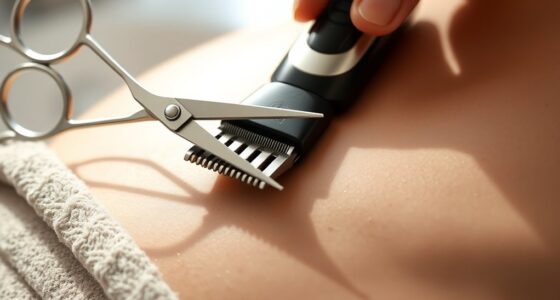To calm post-shave irritation, immediately rinse your skin with cool water to reduce inflammation. Apply an alcohol-free, fragrance-free moisturizer with soothing ingredients like aloe vera or chamomile to help heal and hydrate your skin. Avoid harsh products and don’t scratch or pick at irritated areas. Giving your skin time to recover and adopting gentle shaving techniques can prevent future redness. Keep learning how to soothe and protect your skin to enjoy a comfortable shave every time.
Key Takeaways
- Apply a cool, soothing moisturizer with aloe vera or chamomile immediately after shaving to reduce redness and inflammation.
- Use gentle, alcohol-free, fragrance-free products to prevent further irritation and calm sensitive skin.
- Avoid shaving over irritated skin; give your skin time to recover before shaving again.
- Rinse with cool water post-shave to close pores and reduce heat and inflammation.
- Incorporate calming ingredients like hyaluronic acid to hydrate and soothe the skin effectively.

After shaving, many people notice skin irritation, redness, or a burning sensation, which can be uncomfortable and frustrating. You might feel like your skin is protesting every time you pick up the razor. To soothe this discomfort, understanding proper moisturizing techniques is key. Moisturizing helps restore your skin’s barrier, reduce irritation, and prevent dryness that often worsens post-shave redness. Applying an alcohol-free, fragrance-free moisturizer immediately after shaving can lock in hydration and calm inflamed skin. Look for products with soothing ingredients like aloe vera, chamomile, or hyaluronic acid, which aid in reducing inflammation and promoting healing. Consistently incorporating moisturizing techniques into your routine ensures your skin stays resilient against irritation over time.
Another factor that influences post-shave irritation is your shaving frequency. Shaving too often can strip your skin of natural oils, leaving it dry and more prone to irritation. Conversely, shaving infrequently may cause ingrown hairs or rougher skin, which can also lead to discomfort. Finding the right balance is essential. If you notice persistent redness or burning, consider adjusting how often you shave. Giving your skin time to recover between shaves allows it to heal and reduces the likelihood of irritation. When you do shave, ensure your skin is well-prepared—use warm water to soften hair and open pores, making the shaving process smoother and less abrasive.
Proper shaving techniques complement moisturizing efforts and shaving frequency adjustments. Use a sharp razor to prevent tugging and irritation, and always shave in the direction of hair growth. Avoid applying too much pressure, which can cause micro-cuts and inflammation. After shaving, rinse with cool water to close pores, then gently pat your skin dry before applying moisturizer. This sequence helps minimize irritation and keeps your skin calm.
If you’re prone to post-shave irritation, consider reducing shaving frequency temporarily to allow your skin to recover. During this time, focus on gentle cleansing, hydration, and avoiding harsh products that can exacerbate redness. Over time, as your skin adjusts to your shaving routine, you might be able to shave more frequently without experiencing discomfort. Regular cleansing and maintaining healthy skin air quality, which influences skin health and irritation levels, can also support your overall skincare routine. Remember, consistency in moisturizing techniques and mindful shaving frequency are your best tools for a calmer, irritation-free post-shave experience. By paying attention to these details, you can turn what once was a source of frustration into a manageable routine that keeps your skin healthy and comfortable.
Frequently Asked Questions
Can Post-Shave Irritation Be a Sign of an Allergy?
Yes, post-shave irritation can be a sign of a skin allergy, especially if you notice redness, itching, or swelling that persists. It might also indicate razor sensitivity or an allergic reaction to shaving products like creams or aftershaves. If your irritation worsens or doesn’t improve, consider switching to hypoallergenic products and consult a dermatologist to rule out a skin allergy or adjust your shaving routine.
Are There Specific Ingredients to Avoid After Shaving?
You should avoid alcohol-based products and artificial fragrances after shaving, as they can irritate your skin further. These ingredients dry out your skin and may cause redness or burning sensations. Instead, look for soothing, fragrance-free, and alcohol-free products that calm the skin. Sticking to gentle, hydrating aftershaves or natural remedies helps reduce irritation and keeps your skin healthy and comfortable post-shave.
How Long Does Post-Shave Irritation Typically Last?
Post-shave irritation usually lasts a few hours to a couple of days, depending on your skin sensitivity. To prevent razor burn and soothe your skin, follow a calming skincare routine right after shaving. Use gentle, alcohol-free products and avoid harsh ingredients. Keeping your skin moisturized and avoiding tight clothing can also help. Consistently following these steps promotes faster healing and minimizes irritation, ensuring your skin stays smooth and comfortable.
Can Diet Influence Skin Irritation After Shaving?
Your diet acts like a painter’s palette, influencing your skin’s mood. Yes, diet impact on skin inflammation can worsen or soothe irritation after shaving. Foods high in sugar or processed ingredients can fuel inflammation, making irritation more stubborn. Conversely, eating anti-inflammatory foods like leafy greens, berries, and omega-3s can help calm your skin. Staying hydrated and avoiding alcohol also supports quicker healing, so your skin stays calm and comfortable.
Is It Safe to Use Home Remedies for Irritation?
Yes, it’s generally safe to use home remedies for irritation, especially if you have skin sensitivities. Natural remedies like aloe vera, witch hazel, or cold compresses can soothe your skin and reduce burning. Just make sure you’re not allergic to any ingredients and test a small patch first. If irritation worsens or persists, consult a dermatologist to avoid potential complications.
Conclusion
So, next time you think that a quick shave is worth the irritation, remember: smooth skin isn’t worth the burn. Maybe it’s time to embrace the tiny bumps and redness — after all, they’re just your skin’s way of saying, “I care enough to protest.” Ironically, slowing down and taking care might actually give you the flawless look you’re after, without turning your face into a battlefield. Who knew calm skin could be so rebellious?









